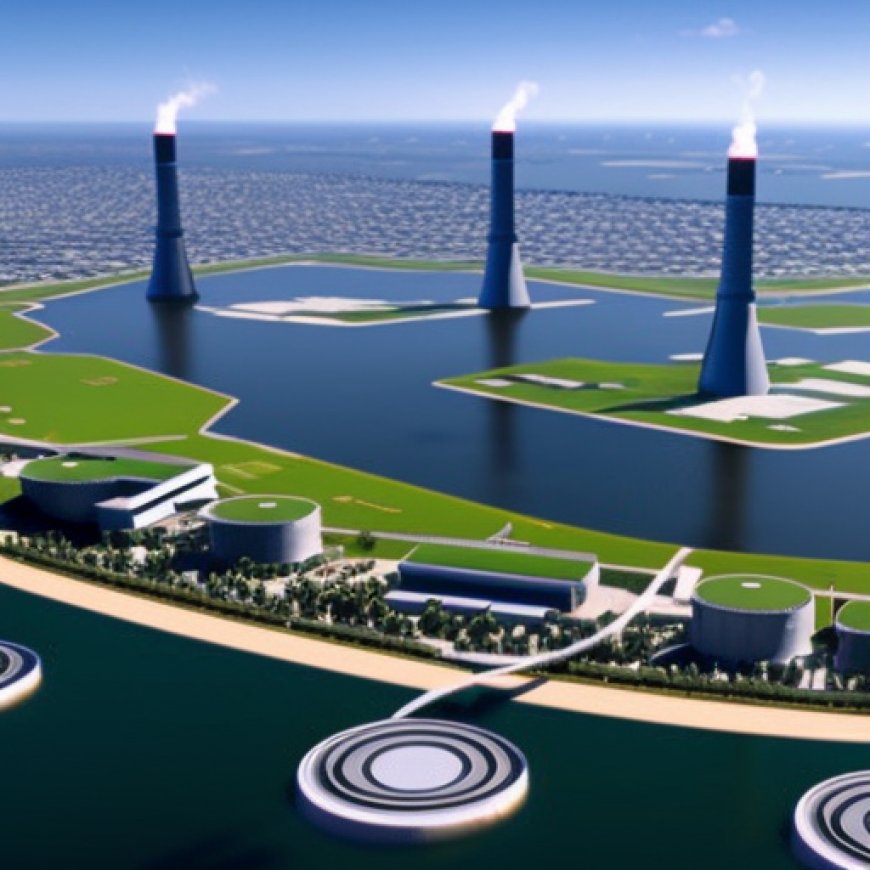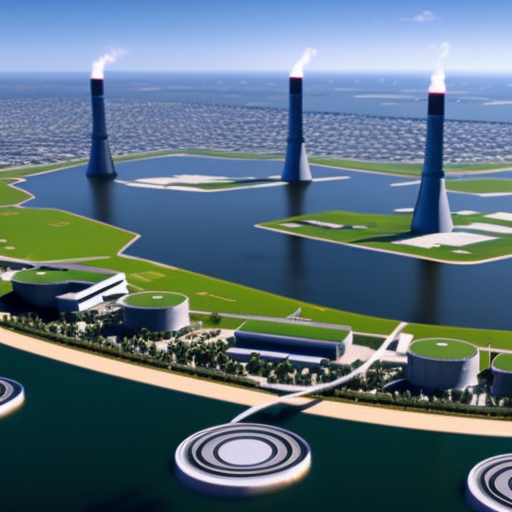‘Giant Methane Factories’: Hydropower Has Long Been Touted as Clean Energy. But Is It? – Inside Climate News
‘Giant Methane Factories’: Hydropower Has Long Been Touted as Clean Energy. But Is It? InsideClimate News


Sustainable Development Goals and the Impact of Hydropower on Carbon Emissions
Mark Easter was disappointed to learn about a recent study from Stanford University that linked the ongoing drought in the American West to an increase in U.S. carbon emissions. The study, published in the Proceedings of the National Academy of Sciences, revealed that dwindling water levels in rivers led to a rise of approximately 121 million metric tons of carbon emissions over the past 20 years. This increase occurred because hydroelectric dams were unable to generate as much power, resulting in states relying on fossil fuel power plants to compensate for the shortfall.
This significant rise in carbon emissions over just two decades is equivalent to having an additional 1.3 million cars on the road during the same period. Furthermore, the study highlighted that local air pollution likely increased due to the burning of fossil fuels, which releases toxic fumes including carcinogens such as benzene and fine particulate matter.
The Carbon Footprint of Hydropower
However, Easter, an ecological consultant working with the environmental advocacy group Save the Colorado and a former senior researcher at Colorado State University’s Natural Resource Ecology Laboratory, pointed out a critical aspect that the study missed: hydropower is far from being a carbon-neutral source of energy.
While the Stanford study focused on the increase in carbon emissions from fossil fuels resulting from a drop in hydropower production, the Environmental Protection Agency estimates that U.S. reservoirs, including those created by hydropower dams, contributed nearly 29 million metric tons of carbon emissions in 2021 alone.
Easter emphasized that reservoirs are significant sources of methane emissions. As organic matter accumulates behind dams and decomposes in the reservoirs, methane is produced. In natural bodies of water, this methane would eventually reach the ocean and undergo chemical reactions that convert it into carbon dioxide and other compounds. However, in the oxygen-depleted waters of a dam reservoir, this transformation often does not occur. As a result, artificial reservoirs have a much larger climate impact than natural bodies of water.
Various studies have shown that the greenhouse gas emissions from many hydroelectric dams can rival those generated by fossil fuel power plants. In fact, a seminal study published in Nature Geoscience found that global methane emissions from reservoirs are increasing over time. This highlights the urgent need to address the climate impact of hydropower and take steps to mitigate it.
The Need for More Research and Reporting
Easter believes that there is a knowledge gap when it comes to understanding the environmental impact of dams. While there is ample research showcasing the broader environmental harms caused by dams, U.S. hydropower facilities are not required to report their emissions. Many governments around the world are just beginning to address this issue by gathering and publishing rough estimates of reservoir emissions.
Last year, the U.S. reported its reservoir emissions for the first time to the United Nations, which has also been slow to address the issue. The U.N. finalized standards for calculating and reporting reservoir emissions in 2019, but some experts argue that these standards underestimate emissions. The Environmental Protection Agency is currently conducting a comprehensive national study of reservoir emissions, which is expected to provide valuable insights into this issue.
More Top Climate News
- Climate Change Is Altering the Color of Our Oceans, New Research Finds: A study published in the journal Nature reveals that more than half of the world’s oceans have changed in color over the past 20 years, likely due to human-caused climate change. This shift in color indicates changes in plankton and other materials in the water, with potential ripple effects on ocean ecosystems.
- Vermont’s Flooding This Week Is Historic. What Role Did Climate Change Play? Massive flooding in Vermont, surpassing even the levels seen during Tropical Storm Irene in 2011, raises questions about the role of climate change in these extreme weather events. Experts, including renowned climate activist Bill McKibben, discuss the connection between climate change and the recent storms.
- COP28 President, a Controversial Oil Executive, Calls for Slashing ‘All Emissions, Everywhere’: Sultan al-Jaber, the head of a United Arab Emirates’ state-run oil company and the president of COP28 climate talks, urges world leaders to take aggressive action to reduce emissions and limit global warming. Climate activists cautiously welcome this call, while also expressing concerns about the influence of the fossil fuel industry on the event.
Today’s Indicator
U.S. carbon emissions fell by 5% in the first five months of this year compared to the same period last year, marking the first time a decline has occurred during President Joe Biden’s tenure. This decrease can be attributed to a mild winter and a sluggish economy.
About the Author
Kristoffer Tigue is a New York City-based reporter for Inside Climate News. He covers environmental justice issues, writes the Today’s Climate newsletter, and manages ICN’s social media. Tigue’s work has been published in Reuters, Scientific American, Public Radio International, and CNBC. He holds a Master’s degree in journalism from the Missouri School of Journalism.
SDGs, Targets, and Indicators Analysis
1. Which SDGs are addressed or connected to the issues highlighted in the article?
- SDG 7: Affordable and Clean Energy
- SDG 13: Climate Action
- SDG 15: Life on Land
The issues highlighted in the article are connected to SDG 7, which focuses on ensuring access to affordable, reliable, sustainable, and modern energy for all. It is also connected to SDG 13, which aims to take urgent action to combat climate change and its impacts. Additionally, the article touches on SDG 15, which aims to protect, restore, and promote sustainable use of terrestrial ecosystems, sustainably manage forests, combat desertification, halt and reverse land degradation, and halt biodiversity loss.
2. What specific targets under those SDGs can be identified based on the article’s content?
- SDG 7.2: Increase substantially the share of renewable energy in the global energy mix
- SDG 13.2: Integrate climate change measures into national policies, strategies, and planning
- SDG 15.1: By 2020, ensure the conservation, restoration, and sustainable use of terrestrial and inland freshwater ecosystems and their services
The article highlights the need to increase the share of renewable energy in the global energy mix (SDG 7.2) by addressing the carbon emissions associated with hydropower and promoting alternative sources of clean energy. It also emphasizes the importance of integrating climate change measures into national policies and planning (SDG 13.2) to mitigate the climate impact of hydropower and reduce carbon emissions. Furthermore, the article raises concerns about the ecological harms caused by dams and the need to ensure the conservation, restoration, and sustainable use of terrestrial ecosystems (SDG 15.1).
3. Are there any indicators mentioned or implied in the article that can be used to measure progress towards the identified targets?
- Indicator for SDG 7.2: Share of renewable energy in the total final energy consumption
- Indicator for SDG 13.2: Number of countries with integrated climate change mitigation, adaptation, impact reduction, and early warning measures incorporated into policies, strategies, planning, and financing
- Indicator for SDG 15.1: Proportion of important sites for terrestrial and freshwater biodiversity that are covered by protected areas, by ecosystem type
The article implies the need to measure the share of renewable energy in the total final energy consumption as an indicator for progress towards SDG 7.2. It also suggests the importance of tracking the number of countries that have integrated climate change measures into their policies, strategies, planning, and financing as an indicator for SDG 13.2. Additionally, the article highlights the need to monitor the proportion of important sites for terrestrial and freshwater biodiversity that are covered by protected areas as an indicator for SDG 15.1.
Table: SDGs, Targets, and Indicators
| SDGs | Targets | Indicators |
|---|---|---|
| SDG 7: Affordable and Clean Energy | Increase substantially the share of renewable energy in the global energy mix | Share of renewable energy in the total final energy consumption |
| SDG 13: Climate Action | Integrate climate change measures into national policies, strategies, and planning | Number of countries with integrated climate change mitigation, adaptation, impact reduction, and early warning measures incorporated into policies, strategies, planning, and financing |
| SDG 15: Life on Land | Ensure the conservation, restoration, and sustainable use of terrestrial and inland freshwater ecosystems and their services | Proportion of important sites for terrestrial and freshwater biodiversity that are covered by protected areas, by ecosystem type |
Behold! This splendid article springs forth from the wellspring of knowledge, shaped by a wondrous proprietary AI technology that delved into a vast ocean of data, illuminating the path towards the Sustainable Development Goals. Remember that all rights are reserved by SDG Investors LLC, empowering us to champion progress together.
Source: insideclimatenews.org

Join us, as fellow seekers of change, on a transformative journey at https://sdgtalks.ai/welcome, where you can become a member and actively contribute to shaping a brighter future.







